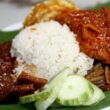Roti canai is a popular flatbread that originated in India but has become a staple in Malaysian cuisine. It is a versatile dish that can be eaten for breakfast, lunch, dinner, or as a snack. In this article, we will take a closer look at roti canai, its history, how it’s made, and some of the popular variations and accompaniments.
A Brief History of Roti Canai
Roti canai has its roots in the southern regions of India, where it is known as parotta. The dish was brought to Malaysia by Indian immigrants and has since become a beloved part of Malaysian cuisine. The word “canai” is thought to have come from the Tamil word “kanai,” which means to roll out or flatten.
The Making of Roti Canai
This is made by mixing flour, water, salt, and sometimes ghee or butter. The dough is kneaded until it is smooth and elastic and then left to rest for several hours. The dough is then rolled out thin, brushed with ghee or butter, and folded into a square or triangle shape. The dough is then fried on a hot griddle until it is golden brown and crispy on the outside but soft and chewy on the inside.
Popular Variations of Roti Canai
While the traditional roti canai is a simple, buttery flatbread, there are many variations of the dish that incorporate different ingredients and flavors. One popular variation is the roti telur, which includes a beaten egg that is folded into the dough before it is fried. This version is often served with a spicy curry sauce or a side of dal.
Another popular variation is the roti planta, which is made with margarine or vegetable oil instead of ghee or butter. This version is lighter and less greasy than the traditional roti canai and is often served with a sweetened condensed milk dip.
Roti bom is a sweeter version of the dish that is made with sugar and is often served as a dessert. The dough is rolled thin and sprinkled with sugar before being fried until crispy and golden brown.
Accompaniments for Roti Canai
This is often served with a side of curry sauce, dal, or sambal, a spicy condiment made from chili peppers, shrimp paste, and other ingredients. The sauce is used to dip the roti canai into or poured over the top of the bread.
Another popular accompaniment is the teh tarik, a sweet, milky tea that is pulled back and forth between two cups to create a frothy texture. The tea is a perfect complement to the buttery and spicy flavors of the roti canai.
In some parts of Malaysia, this is served with a side of banana or durian, two popular fruits in the region. The fruit adds a sweet and refreshing flavor to the dish and is a great way to balance out the spice of the curry sauce or sambal.
Similar Articles
- Asam Pedas: The Spicy and Sour Fish Stew of Malaysia
- Pisang Goreng: The Sweet and Crispy Banana Fritters of Malaysia
- Ikan Bakar: The Spicy and Flavorful Grilled Fish of Malaysia
- Laksa: The Aromatic and Flavorful Soup of Southeast Asia
Conclusion
Roti canai is a beloved dish in Malaysia and has become a popular staple in Malaysian cuisine. Whether it’s served for breakfast, lunch, dinner, or as a snack, this versatile flatbread is sure to delight your taste buds with its buttery, crispy, and chewy texture. With a variety of variations and accompaniments, there’s a roti canai dish for every palate. So, the next time you’re in Malaysia, be sure to try this delicious and iconic dish and experience the rich flavors and culture of this beautiful country.









